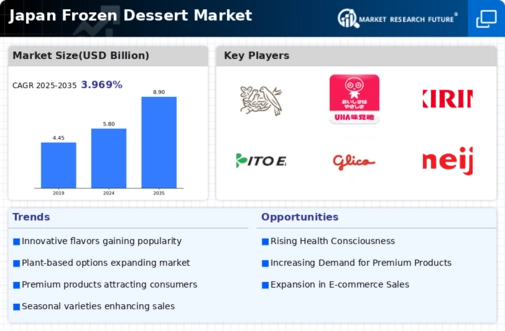Health and Wellness Trends
Health and wellness trends are reshaping the frozen dessert market in Japan. As consumers become more health-conscious, there is a growing demand for lower-calorie and reduced-sugar options. This shift is evident in the introduction of frozen desserts that incorporate natural sweeteners and functional ingredients, such as probiotics. In 2025, products marketed as healthier alternatives are projected to capture around 20% of the market share. The frozen dessert market is responding by reformulating existing products and developing new offerings that align with these health trends, thereby appealing to a broader audience seeking indulgence without compromising their health goals.
Innovative Flavor Profiles
Innovation in flavor profiles significantly influences the frozen dessert market in Japan. Consumers are increasingly adventurous, seeking unique and exotic flavors that go beyond traditional offerings. This trend is evident as specialty flavors, such as matcha and yuzu, gain traction, appealing to both local and international palates. In 2025, the market for innovative flavors is projected to grow by 15%, indicating a strong consumer preference for diverse taste experiences. The frozen dessert market is responding by collaborating with local artisans and chefs to create limited-edition flavors, thereby enhancing brand appeal and attracting a broader customer base.
Growth of E-Commerce Channels
The frozen dessert market in Japan is witnessing a significant shift towards e-commerce channels. The convenience of online shopping, coupled with the ability to access a wider variety of products, is driving this trend. In 2025, e-commerce sales in the frozen dessert market are expected to increase by 25%, reflecting changing consumer purchasing behaviors. Retailers are investing in their online platforms to enhance user experience and streamline delivery processes. The frozen dessert market is thus adapting to this digital transformation, ensuring that consumers can easily access their favorite products from the comfort of their homes.
Rising Demand for Convenience
The frozen dessert market in Japan experiences a notable surge in demand for convenience-driven products. Busy lifestyles and the increasing number of working individuals contribute to this trend. Consumers are seeking quick and easy dessert options that require minimal preparation. This shift is reflected in the growing popularity of single-serve frozen desserts, which accounted for approximately 30% of the market share in 2025. Retailers are responding by expanding their frozen dessert offerings, ensuring that a variety of convenient options are readily available. The frozen dessert market is thus adapting to meet the needs of time-strapped consumers, leading to innovative packaging and product formats that enhance convenience.
Sustainability and Eco-Friendly Practices
Sustainability emerges as a critical driver in the frozen dessert market in Japan. Consumers are increasingly aware of environmental issues and are favoring brands that adopt eco-friendly practices. This includes the use of sustainable packaging and sourcing of ingredients. In 2025, approximately 40% of consumers express a willingness to pay a premium for products that are environmentally friendly. The frozen dessert market is thus compelled to innovate in packaging solutions and ingredient sourcing, aligning with consumer values. Brands that successfully communicate their sustainability efforts are likely to enhance their market position and attract environmentally conscious consumers.




















Leave a Comment